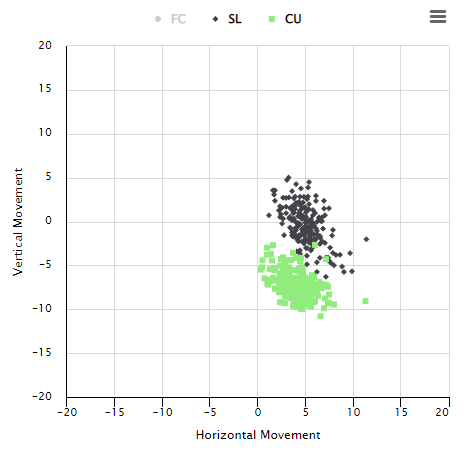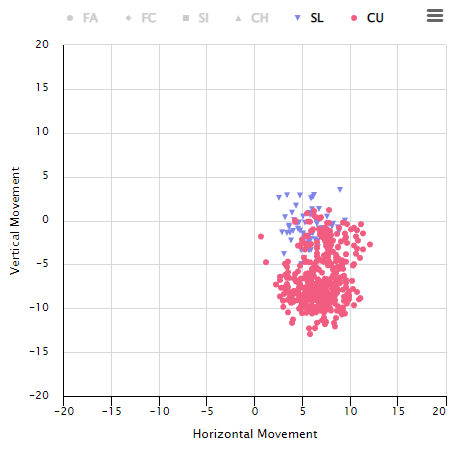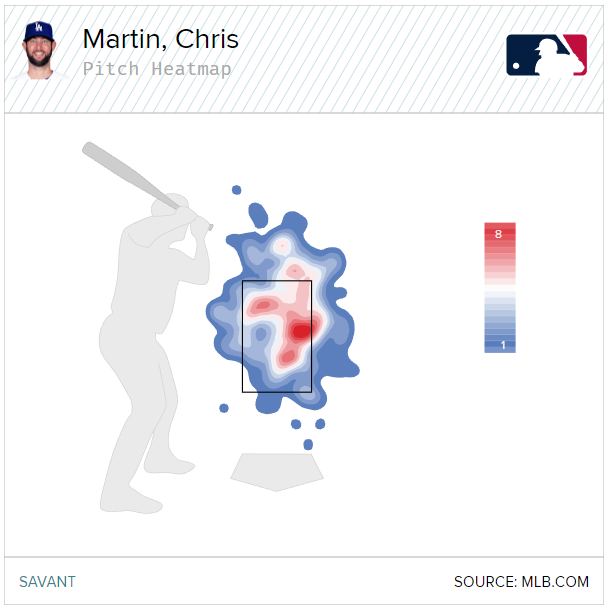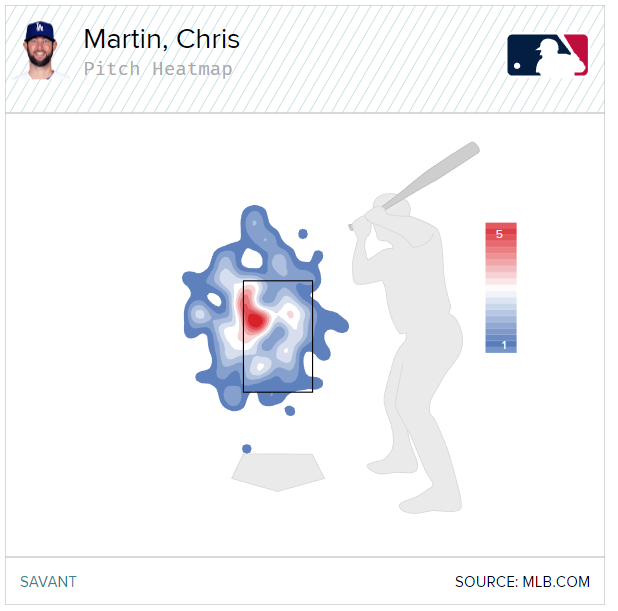Post-Trade Deadline Pitch Mix Changes: Relievers

Yesterday, I took a look at a few starters who have changed their pitch mix after being traded halfway through this season. Today, I’m finishing the set. Here are the relievers who have changed their pitch selection the most in the month after joining new teams. One note: since relievers throw fewer pitches, the variability in their mix is greater; a few extra sliders to get the feel for them in a random game can tip the percentages meaningfully. I’m focusing on five relievers who made interesting changes, but you could add others to the list.
Lou Trivino, New York Yankees
The Change: -12% Four-Seamer, -6% Changeup, +8% Cutter, +14% Slider
Trivino is a rarity, a legitimate five-pitch reliever. He’s thrown his changeup, slider, sinker, cutter, and four-seamer each at least 10% of the time this year, and mixed in an occasional curveball for good measure. The Yankees are working to change that.
Since donning pinstripes, Trivino is down to three pitches he uses at least 10% of the time: sinker, slider, cutter. His slider is new this year, one of the sweeping types that are all the rage these days, and he’d already taken to the pitch in Oakland, using it nearly 20% of the time. He’s using it even more in New York; a third of the pitches he’s thrown as a Yankee have been sliders.
Something had to give to accommodate those extra sliders, and Trivino has done the natural thing: cutting down on his four-seamer, the lesser of his two fastballs. His sinker also pairs better horizontally with the sweeping slider, which makes this a no-brainer. It’s not always as easy as throwing your best pitches more – the slider looks like his best secondary pitch to me – but in this case, the combination of a sinker/slider pitcher and a team that loves those exact guys makes perfect sense.
As for the changeup decrease, I wouldn’t read too much into it. That comes down to a platoon situation. The A’s used Trivino against righties and lefties – 61.6% of the batters he faced there were righties. In New York, that number is up to 70%, which means fewer opportunities to throw his excellent changeup. His changeup rate to left-handed batters is virtually unchanged.
That just leaves the cutter, which is an interesting one. With the Yankees, Trivino has been using a cutter/changeup approach to lefties, going to the cutter nearly 40% of the time. That’s no accident: after losing its shape last year, Trivino’s cutter is back to its once-excellent form. In essence, he hadn’t been cutting it enough, so it showed arm-side break, which is no way to use a cutter. You want as much separation from a “normal” fastball as possible; any arm-side run is just moving the ball towards where your opponent expects it to go. With the Yankees, he’s getting more glove-side movement, and I think he’ll use more cutters against both lefties and righties as he gains comfort with it. In essence, this version of Trivino looks nothing like the Trivino of 2021 and earlier this season; he’s 2018-20 Trivino plus a sweeping slider. Sounds good to me!
Scott Effross, New York Yankees
The Change: -8% Sinker, +6% Four-Seamer
Never let it be said that the Yankees only know one way to change relievers. Before hitting the injured list with a shoulder strain, Effross made a completely different fastball change, nearly doubling his four-seamer usage. But it’s no ordinary four-seamer:
Thanks to his arm slot, Effross’ four-seamer almost looks like a sinker. But it doesn’t look like his sinker, which seems to be the key; in New York, Effross has stopped throwing sinkers to lefties and gone almost completely to four-seamers instead. I think this has a lot to do with pitch shape and location; throwing a sinker to lefties from Effross’ low release point means giving them a good look at a pitch that needs to catch the plate to be effective.
I’m not sure that the four-seamer is an objectively better pitch, but I think it’s a clever change. Sidearmers throw a ton of sinkers and not many four-seamers, so a new wrinkle should hopefully make opposing batters uncomfortable. Effross doesn’t need the help against righties, but it’s just a fact that pitchers with his general profile struggle against left-handed batters. Doing something to mitigate that weakness makes good sense to me, especially if you can command your new fastball, something Effross has done with aplomb.
David Robertson, Philadelphia Phillies
The Change: -11% Cutter, -6% Curve, +17% Slider
The Yankee train keeps on rolling, this time with an old friend rather than a new arrival. Robertson is a cutter/curveball pitcher and always has been. This year, though, he’s been toying with a new slider, and he’s thrown the pitch far more frequently since being traded to the Phillies in early August.
What gives? As unsatisfying as this is, it’s quite hard to tell. Robertson had already been experimenting with a slider while with the Cubs, and I’m not even sure it’s a new pitch. He throws it at the same speed, spin rate, and gyro percentage as his curveball, though with meaningfully different break. In other words, it’s a curveball in slider’s clothing, more a variant than a new pitch. Take a look at the movement profile of the two pitches:

So what’s going on? This feels less like a pitch change than a tweak. I like the straight curveball more, for a fairly obvious reason: it has more total break and thus misses more bats. But the slider has a place, too. When batters look for a curveball, they’re way too low on the slider, which results in a ton of easy outs (five of the 29 batted balls against the pitch have been pop ups). More than anything, this feels like a classification issue; take a look at the curveballs and sliders he threw in 2017, one of his most dominant seasons:

Oh, well then. I guess this is just a classification issue. Robertson is a great reliever, whether you want to call his breaking ball two pitches or one.
Raisel Iglesias, Atlanta Braves
The Change: -12% Slider, +5% Four-Seam, +9% Changeup
I included this one because the absolute numbers are high, but there’s nothing to see here. Iglesias has faced more lefties as a Brave, so he’s using his changeup more. No change in pitch mix, merely a platoon change. Next!
Chris Martin, Los Angeles Dodgers
The Change: -4% Sinker, -4% Curveball, -4% Changeup, +12% Four-Seamer
Oh man, this one is a delight. As we all know, smart teams hate fastballs. As we all know, the Dodgers are a smart team. Martin doesn’t even throw that hard – he’s 94-96 mph, which is basically average reliever velocity these days. Naturally, the Dodgers had him throw more four-seamers and less of everything else, and he’s been phenomenal for them, with a 2.51 ERA and 1.51 FIP.
Why make this change? It’s because Martin’s fastball is really good, obviously. Martin doesn’t get a ton of ride on his fastball. He doesn’t have an unusual release point, or an extremely shallow vertical approach angle that could make the pitch play up. What he does have is pinpoint command. His calling card is moving the ball across the strike zone depending on his opponent. Here’s his location against righties:

Not too shabby, but check out his location against lefties:

Martin keeps his fastball away from everyone, limiting their ability to lift and pull the ball. Since joining the Dodgers, he’s been on an absolute tear with the pitch; fully a quarter of the fly balls opponents have hit against him since his arrival in LA haven’t left the infield. That’s how you end up with a .176 BABIP and the expected contact quality numbers to match.
Will this plan continue to work? I’m skeptical, but maybe I shouldn’t be. He’s only thrown 200 pitches with the Dodgers; it’s entirely possible that this is nothing more than a sample size artifact. I’m not saying pitchers can’t survive on location alone. For an example of that, look no farther than Martin himself; he’s never had a FIP above 4.00 in a full major league season, churning out excellent relief work every year. Disregard Martin’s pitch mix changes – but do believe the talent, because there’s nothing in his history to suggest he’ll stop getting batters out any time soon.
Ben is a writer at FanGraphs. He can be found on Bluesky @benclemens.

Chris Martin is also 6’8″ which has to affect the way his fastball plays.
Pretty standard stride length though, he’s in the 64th percentile in Extension